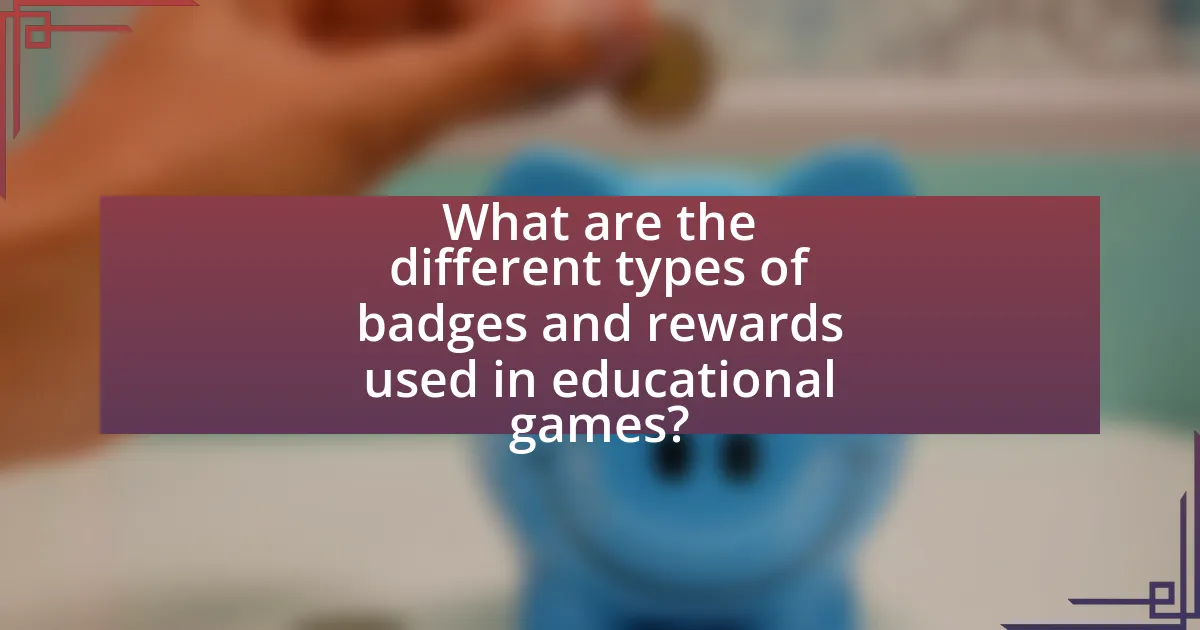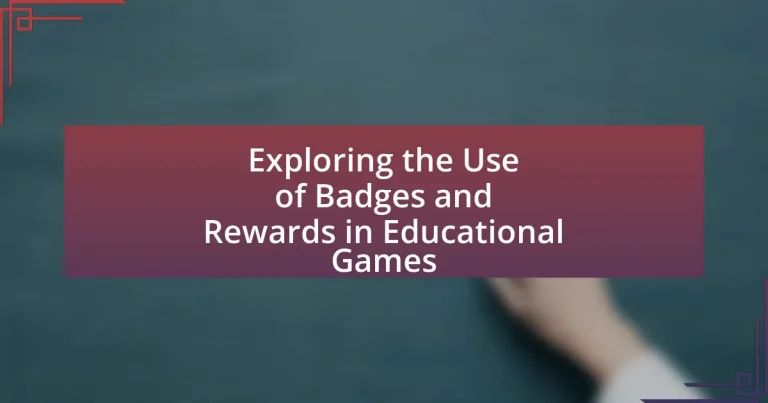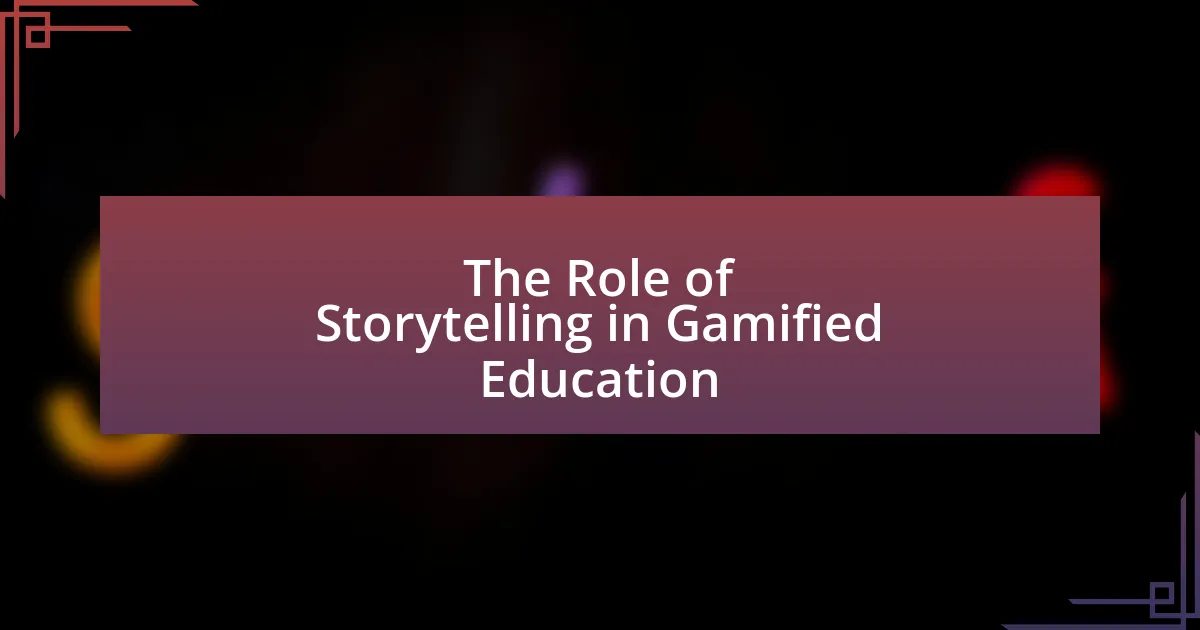The article focuses on the use of badges and rewards in educational games, highlighting their role as motivational tools that recognize learners’ achievements and progress. It discusses various types of badges, such as achievement, participation, skill, and completion badges, and explains how these elements enhance student engagement and learning outcomes. The article also examines the psychological effects of badges and rewards, differentiating between intrinsic and extrinsic motivations, and outlines best practices for educators to implement effective badge systems aligned with learning objectives. Additionally, it addresses challenges educators may face and explores future trends and innovations in gamification within educational contexts.

What are Badges and Rewards in Educational Games?
Badges and rewards in educational games are mechanisms used to recognize and incentivize learners’ achievements and progress. These elements serve to motivate students by providing tangible acknowledgments of their skills, efforts, and milestones reached within the game. Research indicates that incorporating badges can enhance engagement and learning outcomes, as they create a sense of accomplishment and encourage continued participation. For instance, a study by Hamari, Koivisto, and Sarsa (2014) found that gamification elements like badges significantly increased user motivation and engagement in educational contexts.
How do badges and rewards function within educational games?
Badges and rewards in educational games serve as motivational tools that recognize and reinforce player achievements. They function by providing tangible acknowledgment of skills acquired or milestones reached, which can enhance engagement and encourage continued participation. Research indicates that the use of badges can lead to increased motivation and improved learning outcomes, as players often strive to earn these rewards, thereby fostering a sense of accomplishment and progress. For instance, a study by Hamari, Koivisto, and Sarsa (2014) found that gamification elements like badges significantly influenced user engagement and satisfaction in educational contexts.
What types of badges are commonly used in educational games?
Common types of badges used in educational games include achievement badges, participation badges, skill badges, and completion badges. Achievement badges recognize specific accomplishments, such as mastering a concept or reaching a milestone. Participation badges reward users for engaging with the game, encouraging consistent involvement. Skill badges are awarded for demonstrating proficiency in particular skills or tasks, while completion badges signify the successful finishing of levels or challenges. These badge types are designed to motivate learners and provide tangible recognition of their progress and efforts in educational contexts.
How do rewards enhance the learning experience in games?
Rewards enhance the learning experience in games by providing motivation and reinforcing desired behaviors. When players receive rewards, such as badges or points, they experience a sense of achievement, which encourages continued engagement and effort. Research indicates that rewards can lead to increased intrinsic motivation, as players associate their progress with skill development and mastery. For instance, a study by Hamari et al. (2016) found that gamification elements, including rewards, significantly improve user engagement and learning outcomes in educational contexts. This demonstrates that rewards not only incentivize participation but also facilitate deeper learning by creating a positive feedback loop that encourages players to explore and learn more effectively.
Why are badges and rewards important in educational contexts?
Badges and rewards are important in educational contexts because they enhance motivation and engagement among learners. Research indicates that the use of badges can lead to increased participation and persistence in educational activities, as they provide tangible recognition of achievements. For instance, a study by Hamari, Koivisto, and Sarsa (2014) found that gamification elements, including badges, significantly improved user engagement in educational settings. This recognition not only fosters a sense of accomplishment but also encourages learners to set and achieve personal goals, thereby promoting a growth mindset.
What psychological effects do badges and rewards have on learners?
Badges and rewards significantly enhance learners’ motivation and engagement. These psychological effects stem from the principles of operant conditioning, where positive reinforcement encourages desired behaviors. Research indicates that learners who receive badges report higher levels of intrinsic motivation, as badges serve as tangible recognition of achievement, fostering a sense of accomplishment. A study by Hamari, Koivisto, and Sarsa (2014) found that gamification elements, including badges, positively influence user engagement and motivation in educational contexts. This demonstrates that badges and rewards not only validate learners’ efforts but also stimulate continued participation and effort in learning activities.
How do badges and rewards influence student motivation and engagement?
Badges and rewards significantly enhance student motivation and engagement by providing tangible recognition of achievements and progress. Research indicates that when students receive badges for completing tasks or mastering skills, they experience increased intrinsic motivation, as these rewards serve as a form of positive reinforcement. For instance, a study by Hamari, Koivisto, and Sarsa (2014) found that gamification elements, including badges, can lead to higher engagement levels in educational settings, as they create a sense of accomplishment and encourage continued participation. Additionally, badges can foster a competitive spirit among students, motivating them to strive for higher performance and deeper learning.

What are the different types of badges and rewards used in educational games?
Educational games utilize various types of badges and rewards to enhance motivation and engagement among learners. Common types include achievement badges, which recognize specific accomplishments; participation badges, awarded for completing tasks or engaging in activities; skill badges, indicating mastery of particular skills; and challenge badges, given for overcoming difficult tasks. Research indicates that these rewards can significantly increase student motivation and learning outcomes, as evidenced by studies showing that gamification elements, including badges, lead to higher engagement levels and improved performance in educational settings.
How are intrinsic and extrinsic rewards differentiated in educational games?
Intrinsic rewards in educational games are internal satisfactions derived from the learning experience itself, such as the joy of mastering a skill or the satisfaction of solving a challenging problem. In contrast, extrinsic rewards are external incentives provided to players, such as badges, points, or certificates, which serve to motivate and recognize achievement. Research indicates that while intrinsic rewards can enhance engagement and foster a love for learning, extrinsic rewards can effectively motivate players to complete tasks and achieve specific goals, as evidenced by studies showing that gamification elements like badges can increase participation and performance in educational settings.
What are examples of intrinsic rewards in educational gaming?
Examples of intrinsic rewards in educational gaming include mastery of skills, personal achievement, and enjoyment of the learning process. Mastery of skills occurs when players successfully complete challenges or levels, reinforcing their understanding and competence in the subject matter. Personal achievement is experienced when players set and reach their own goals, fostering a sense of accomplishment. Enjoyment of the learning process is intrinsic as players engage with the game mechanics and narrative, leading to a deeper connection with the educational content. These intrinsic rewards enhance motivation and engagement, making the learning experience more effective.
What are examples of extrinsic rewards in educational gaming?
Examples of extrinsic rewards in educational gaming include badges, points, and certificates. Badges serve as visual representations of achievements, motivating players to complete tasks or reach milestones. Points are often awarded for completing levels or challenges, providing a quantifiable measure of progress. Certificates can be issued upon completion of a course or game, offering formal recognition of the player’s efforts and accomplishments. These rewards enhance engagement and encourage continued participation in educational activities.
What role do digital badges play in educational assessment?
Digital badges serve as a form of recognition in educational assessment, validating learners’ achievements and skills. They provide a visual representation of competencies acquired through various learning activities, making it easier for educators to track progress and for students to showcase their accomplishments. Research indicates that digital badges can enhance motivation and engagement, as they offer tangible rewards for learning milestones. For instance, a study by Casilli and de Freitas (2016) found that badges can positively influence student motivation and self-efficacy, thereby improving overall learning outcomes.
How can digital badges be used to track student progress?
Digital badges can be used to track student progress by providing a visual representation of skills and achievements that students have acquired over time. These badges serve as indicators of mastery in specific competencies, allowing educators to assess individual learning paths and identify areas needing improvement. Research shows that 70% of educators believe digital badges motivate students and enhance engagement, as they create a sense of accomplishment and encourage goal-setting. By systematically issuing badges for completed tasks, projects, or milestones, educators can effectively monitor and document student progress in a structured manner.
What are the criteria for earning digital badges in educational games?
Digital badges in educational games are earned based on specific criteria such as skill mastery, completion of tasks, and participation in challenges. These criteria often include demonstrating proficiency in a subject area, achieving a certain score or level, and engaging in collaborative activities. For instance, a study by Hamari et al. (2016) highlights that badges serve as recognition for accomplishments, motivating learners to reach defined educational goals. Additionally, badges may require players to complete specific quests or demonstrate critical thinking skills, reinforcing the educational objectives of the game.

How can educators effectively implement badges and rewards in educational games?
Educators can effectively implement badges and rewards in educational games by aligning them with specific learning objectives and providing immediate feedback. This approach ensures that students understand the criteria for earning badges, which motivates them to engage with the material. Research indicates that when badges are tied to clear achievements, such as mastering a skill or completing a task, they enhance student motivation and learning outcomes. For instance, a study by Hamari, Koivisto, and Sarsa (2014) found that gamification elements, including badges, significantly increased user engagement in educational contexts. By integrating badges as part of a structured reward system, educators can foster a sense of accomplishment and encourage continuous improvement among students.
What strategies can educators use to design effective badge systems?
Educators can design effective badge systems by ensuring that badges are aligned with clear learning objectives and competencies. This alignment helps students understand the skills they need to demonstrate to earn each badge, fostering motivation and engagement. Additionally, incorporating a variety of badge types, such as achievement, participation, and skill-based badges, can cater to diverse learner preferences and encourage a broader range of student involvement. Research indicates that when badges are tied to specific, measurable outcomes, they enhance student motivation and achievement (Gibson, 2015, “The Role of Badges in Learning”). Furthermore, providing timely feedback and opportunities for reflection on badge achievements can reinforce learning and encourage continuous improvement.
How can educators align badges with learning objectives?
Educators can align badges with learning objectives by clearly defining the skills and knowledge that each badge represents and ensuring these criteria directly correspond to the established learning goals. For instance, if a learning objective is to develop critical thinking skills, the badge criteria should include specific tasks or assessments that demonstrate mastery of critical thinking. Research indicates that when badges are explicitly linked to learning outcomes, such as in the study “Badges in Education: A New Approach to Learning” by K. T. McDaniel and J. M. H. McDaniel, students are more motivated and engaged, leading to improved educational outcomes. This alignment fosters a clear understanding of expectations and provides tangible recognition of student achievements.
What are best practices for integrating rewards into game-based learning?
Best practices for integrating rewards into game-based learning include aligning rewards with learning objectives, providing immediate feedback, and ensuring that rewards are meaningful and varied. Aligning rewards with learning objectives ensures that students are motivated to achieve specific educational goals, enhancing their engagement and retention of knowledge. Immediate feedback reinforces learning by allowing students to understand the consequences of their actions right away, which can lead to improved performance. Additionally, offering a variety of rewards, such as badges, points, or unlockable content, caters to different student preferences and keeps motivation high. Research indicates that these strategies can significantly enhance student engagement and learning outcomes in educational games.
What challenges do educators face when using badges and rewards?
Educators face several challenges when using badges and rewards, including issues of motivation, equity, and assessment. Motivation can be undermined if students focus more on earning badges than on the learning process itself, leading to superficial engagement. Equity challenges arise when not all students have equal access to resources or opportunities to earn badges, potentially widening achievement gaps. Additionally, assessing the true value of badges can be difficult, as they may not accurately reflect a student’s understanding or mastery of content. Research indicates that while badges can enhance engagement, their effectiveness is contingent upon thoughtful implementation and alignment with educational goals.
How can educators address potential issues with over-reliance on rewards?
Educators can address potential issues with over-reliance on rewards by implementing a balanced approach that includes intrinsic motivation strategies alongside extrinsic rewards. This can involve fostering a classroom environment that emphasizes personal growth, self-reflection, and the joy of learning, rather than solely focusing on tangible rewards. Research indicates that intrinsic motivation leads to deeper engagement and sustained interest in learning, as highlighted in Deci and Ryan’s Self-Determination Theory, which emphasizes the importance of autonomy, competence, and relatedness in motivating learners. By integrating these principles, educators can reduce dependency on rewards while promoting a more meaningful educational experience.
What are common misconceptions about badges and rewards in education?
Common misconceptions about badges and rewards in education include the belief that they solely motivate students through extrinsic rewards, leading to superficial learning. This view overlooks research indicating that badges can also foster intrinsic motivation by recognizing mastery and achievement, thereby enhancing engagement and learning outcomes. Additionally, some educators mistakenly think that badges are merely a gimmick; however, studies show that when implemented thoughtfully, badges can provide meaningful feedback and encourage skill development. For instance, a study by the University of Michigan found that digital badges can improve student performance and persistence in learning tasks.
What are the future trends in the use of badges and rewards in educational games?
Future trends in the use of badges and rewards in educational games include increased personalization, integration of blockchain technology, and a focus on social recognition. Personalization allows badges to be tailored to individual learning paths, enhancing motivation and engagement. Blockchain technology can provide secure and verifiable credentials, ensuring the authenticity of achievements. Additionally, social recognition through sharing achievements on social media platforms is expected to foster community and competition among learners. These trends are supported by research indicating that personalized learning experiences and social interactions significantly improve educational outcomes.
How might technology influence the evolution of badges and rewards?
Technology significantly influences the evolution of badges and rewards by enabling more personalized and dynamic systems for tracking and recognizing achievements. With advancements in data analytics and artificial intelligence, educational games can now tailor badge systems to individual learning paths, providing real-time feedback and motivation based on user performance. For instance, platforms like Khan Academy utilize adaptive learning technologies to award badges that reflect specific skills mastered, thus enhancing user engagement and learning outcomes. This shift towards data-driven, personalized recognition systems demonstrates how technology can create more meaningful and effective reward structures in educational contexts.
What innovations are emerging in the realm of gamification in education?
Innovations in gamification in education include the integration of personalized learning paths, adaptive feedback systems, and the use of blockchain technology for credentialing. Personalized learning paths allow students to progress at their own pace, enhancing engagement and retention. Adaptive feedback systems provide real-time assessments, enabling educators to tailor instruction based on individual performance. Blockchain technology offers secure and verifiable digital badges and certificates, which can motivate learners by recognizing their achievements in a transparent manner. These innovations are supported by research indicating that gamified elements can significantly improve student motivation and learning outcomes.
What practical tips can educators follow when using badges and rewards in educational games?
Educators can enhance the effectiveness of badges and rewards in educational games by ensuring that these incentives are aligned with specific learning objectives. This alignment helps students understand the purpose of the rewards and motivates them to achieve educational goals. Additionally, educators should provide immediate feedback when students earn badges, as research indicates that timely recognition reinforces learning and encourages continued engagement. Furthermore, incorporating a variety of badges that cater to different skills and achievements can appeal to diverse learner preferences, promoting inclusivity and motivation. Lastly, educators should regularly assess the impact of badges and rewards on student performance and engagement, allowing for adjustments to be made based on data-driven insights.





